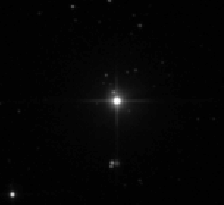AU Microscopii
| Observation data Epoch J2000 Equinox J2000 | |
|---|---|
| Constellation | Microscopium |
| Right ascension | 20h 45m 09.53147s[1] |
| Declination | –31° 20′ 27.2425″[1] |
| Apparent magnitude (V) | 8.73[2] |
| Characteristics | |
| Spectral type | M1Ve[2] |
| U−B color index | 1.01 |
| B−V color index | 1.45 |
| Variable type | Flare star |
| Astrometry | |
| Radial velocity (Rv) | –6.0[2] km/s |
| Proper motion (μ) | RA: +279.96[1] mas/yr Dec.: -360.61[1] mas/yr |
| Parallax (π) | 102.9432 ± 0.0231[3] mas |
| Distance | 31.683 ± 0.007 ly (9.714 ± 0.002 pc) |
| Absolute magnitude (MV) | 8.61 |
| Details | |
| Mass | 0.50 ± 0.03[4] M☉ |
| Radius | 0.75 ± 0.03[4] R☉ |
| Luminosity | 0.09[5] L☉ |
| Temperature | 3,700 ± 100[4] K |
| Rotational velocity (v sin i) | 9.3[2] km/s |
| Age | 22 ± 3[4] Myr |
| Other designations | |
CD -31°17815, GCTP 4939.00, GJ 803, HD 197481, HIP 102409, LTT 8214, SAO 212402, Vys 824, LDS 720 A. | |
| Database references | |
| SIMBAD | data |
| ARICNS | data |
AU Microscopii (AU Mic) is a young small star located about 32 light-years (9.8 parsecs) away – about 8 times as far as the closest star after the Sun.[6] The apparent visual magnitude of AU Microscopii is 8.73,[2] which is too dim to be seen with the naked eye. It was given this designation because it is in the southern constellation Microscopium and is a variable star. Like β Pictoris, AU Microscopii has a circumstellar disk of dust known as a debris disk and at least two exoplanets.
Stellar properties[]
AU Mic is a young star at only 22 million years old; less than 1% of the age of the Sun.[4] With a stellar classification of M1 Ve,[2] it is red dwarf star[7] with a physical radius of 75% that of the Sun. Despite being half the Sun's mass,[8][9] it is radiating only 9%[5] as much luminosity as the Sun. This energy is being emitted from the star's outer atmosphere at an effective temperature of 3,700 K, giving it the cool orange-red hued glow of an M-type star.[10] AU Microscopii is a member of the β Pictoris moving group.[11][12] AU Microscopii may be gravitationally bound to the binary star system AT Microscopii.[13]
AU Microscopii has been observed in every part of the electromagnetic spectrum from radio to X-ray and is known to undergo flaring activity at all these wavelengths.[14][15][16][17] Its flaring behaviour was first identified in 1973.[18][19] Underlying these random outbreaks is a nearly sinusoidal variation in its brightness with a period of 4.865 days. The amplitude of this variation changes slowly with time. The V band brightness variation was approximately 0.3 magnitudes in 1971; by 1980 it was merely 0.1 magnitudes.[20]
Planetary system[]
| Companion (in order from star) |
Mass | Semimajor axis (AU) |
Orbital period (days) |
Eccentricity | Inclination | Radius |
|---|---|---|---|---|---|---|
| b | 20.12+1.72 −1.57[24] M |
